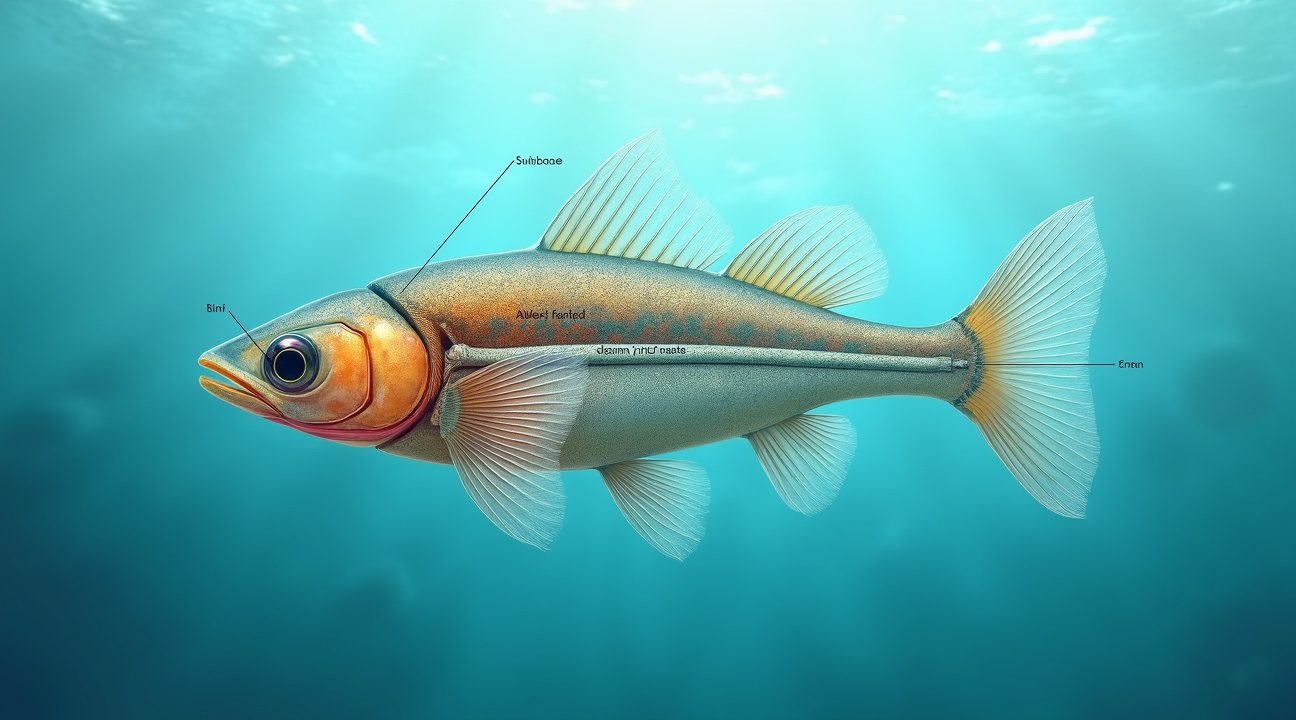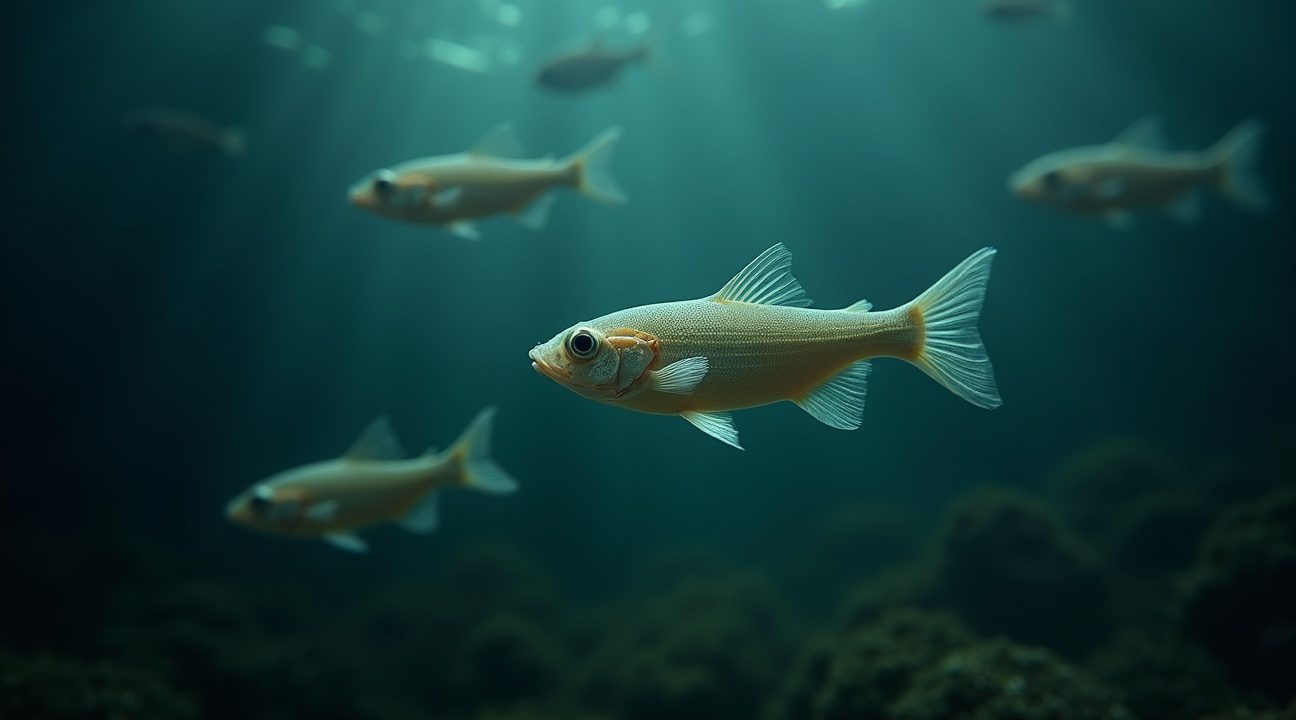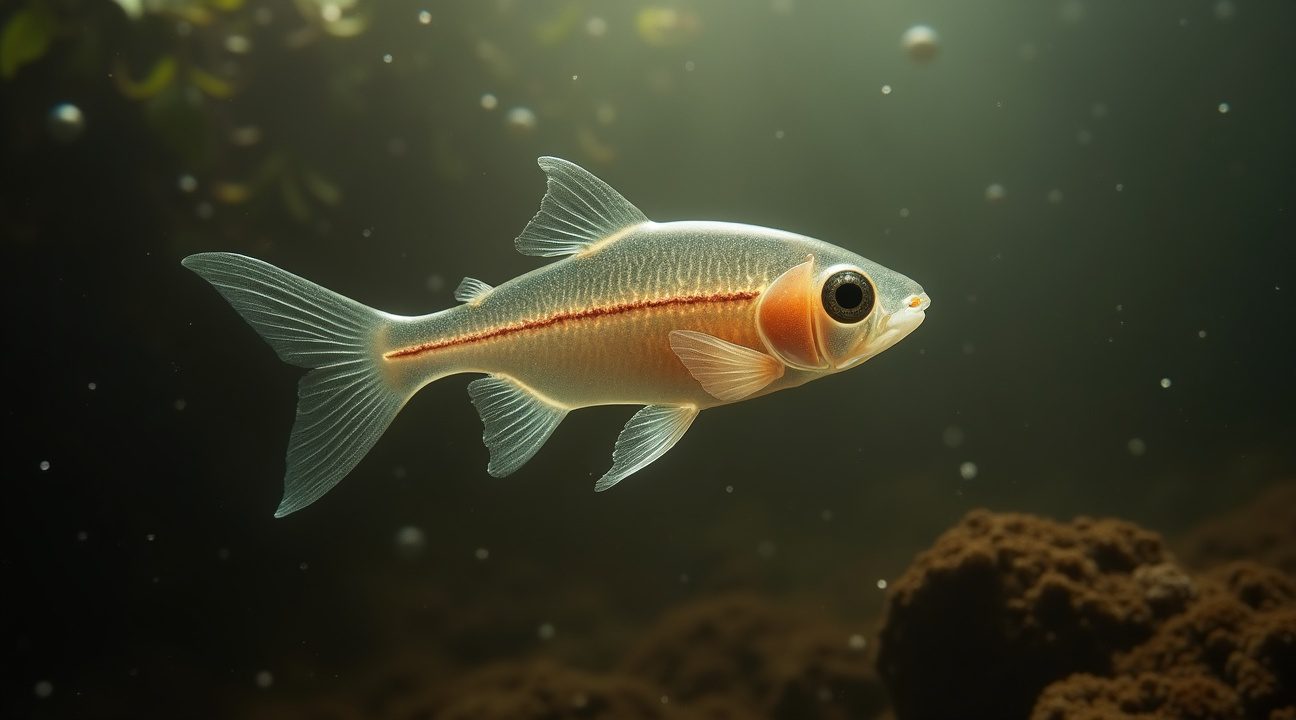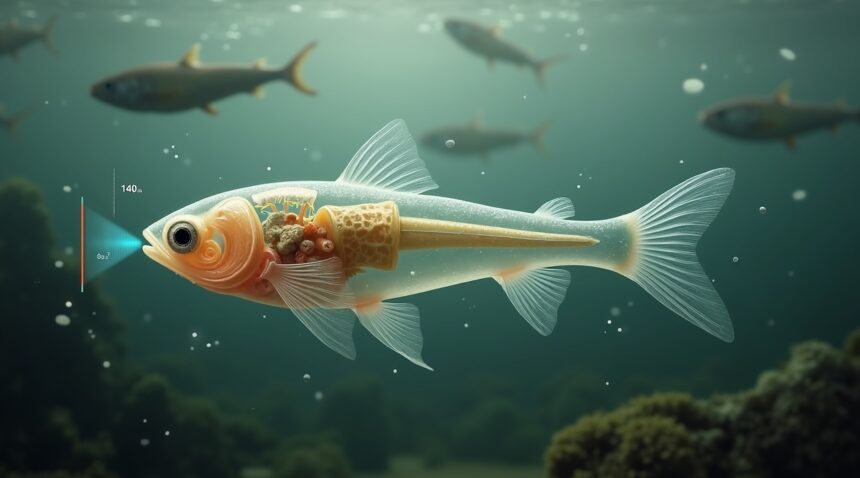Danionella cerebrum, a transparent fish scarcely larger than a fingernail, has astonished the scientific community by generating sounds exceeding 140 decibels—outpacing elephants and rivaling the intensity of jet engines at takeoff.
Key Takeaways
- Record-breaking acoustics: Despite weighing under 100 milligrams, male Danionella cerebrum can emit sounds greater than 140 decibels, measured at close distances of just 10–12 millimeters from their bodies.
- Unique biomechanical system: This miniature fish uses a remarkable catch-and-release mechanism. It includes specialized ribs, drumming cartilage, and sonic muscles capable of accelerating at over 2,000 g—forces that would be lethal to humans.
- Exclusive male vocalization: Only the males produce these high-intensity sounds. They develop this capability around four weeks of age to engage in territorial confrontations, attract mates, and communicate in the dark, sediment-heavy waters of Myanmar.
- Fastest vertebrate movement: The sound-producing system in Danionella cerebrum moves faster than any previously recorded skeletal movement in vertebrates—outpacing even mantis shrimp strikes and the wing beats of hummingbirds.
- Scientific breakthrough potential: Thanks to the fish’s lifelong transparency, scientists can observe brain activity and neural circuits in real-time, especially during sound production. This makes the species highly valuable for both neuroscience studies and innovations in bio-inspired engineering. Learn more about this discovery in Nature’s coverage of the study.
This Fingernail-Sized Fish Produces Sounds Louder Than Elephants and Jet Engines
I’ve discovered one of nature’s most extraordinary acoustic phenomena lurking in the freshwater streams of Myanmar. The male Danionella cerebrum, measuring barely the length of a fingernail, produces sounds that shatter expectations about animal communication. This microscopic marvel generates acoustic signals exceeding 140 decibels at distances of just 10–12 millimeters from its body – a distance roughly equivalent to one body length.
The sheer volume these tiny fish achieve rivals some of the loudest sounds in the animal kingdom. Male Danionella cerebrum can produce calls that equal or surpass the thunderous trumpeting of elephants, creatures weighing thousands of times more. The comparison becomes even more striking when I consider that these fish generate noise levels comparable to fireworks exploding overhead, jet engines roaring to life, or commercial aircraft accelerating during takeoff at distances of 100 meters.
Acoustic Patterns and Frequency Characteristics
The clicking sounds these remarkable fish produce follow distinct acoustic patterns that scientists have carefully documented. Males typically generate their calls in brief pulses operating at specific frequencies of 60 Hz or 120 Hz. These aren’t random bursts of noise but precisely controlled acoustic signals that serve important biological functions.
The fish demonstrate remarkable control over their sound production, chaining individual clicks together in various configurations. They can create short, rapid-fire bursts lasting mere fractions of a second, or extend their vocalizations into prolonged series that continue for several seconds. This flexibility in acoustic output suggests a sophisticated communication system that extends far beyond simple noise-making.
What makes this acoustic achievement even more impressive is the physical constraints these fish face. Producing sounds over 140 decibels requires tremendous energy output relative to body size. Consider that researchers find fish in extreme environments often develop specialized adaptations, and the Danionella cerebrum‘s acoustic abilities represent one of the most remarkable adaptations I’ve encountered.
The frequency characteristics of their calls – particularly the consistent 60 Hz and 120 Hz patterns – indicate precise muscular control over their sound-producing organs. These frequencies fall within ranges that travel effectively through water, suggesting evolution has fine-tuned these fish for optimal acoustic communication in their aquatic environment.
Scientists believe these powerful vocalizations serve multiple purposes, including:
- Territorial disputes
- Mating displays
- Individual identification among dense populations
The ability to produce such loud sounds gives males a significant advantage in crowded freshwater habitats where visual cues might be limited. The clicking patterns likely convey information about the caller’s size, health, and reproductive status to potential mates and rivals.
The discovery of such powerful sound production in such a small organism challenges our understanding of bioacoustics. It demonstrates that size doesn’t necessarily determine acoustic capability, and that evolution can produce extraordinary solutions to communication challenges. The Danionella cerebrum proves that sometimes the smallest packages contain the biggest surprises, generating sounds that would make much larger creatures envious while operating within the confines of a body smaller than most people’s thumbnails.
The Extraordinary Physics Behind Nature’s Loudest Little Vertebrate
Danionella cerebrum achieves its remarkable acoustic performance through an ingenious mechanical system that operates on principles fundamentally different from other sound-producing fish. Unlike species that rely on direct muscle contractions to generate noise, this fingernail-sized fish employs a sophisticated “catch-and-release” mechanism that amplifies force in ways that seem almost engineered.
Specialized Anatomy for Maximum Impact
The fish’s sound production system centers on three critical anatomical components working in perfect coordination:
- The drumming cartilage serves as the primary percussion element.
- A specialized rib acts as both a lever and energy storage device.
- A fatigue-resistant sonic muscle provides the initial force that sets the entire system in motion.
These structures work together to create what researchers describe as one of nature’s most efficient acoustic amplification systems.
I find it fascinating how the sonic muscle doesn’t need to contract at impossibly high frequencies like other fish species. Instead, it builds tension gradually in the specialized rib, which stores this mechanical energy like a loaded spring. This approach allows the fish to generate tremendous acoustic power without placing excessive demands on muscle fiber performance.
The Biomechanical Marvel of Sound Generation
The actual sound production occurs through a precisely timed sequence of events that unfolds in milliseconds:
- The sonic muscle contracts and pulls on the specialized rib, creating mounting tension in the drumming cartilage.
- This tension continues building until it reaches a critical threshold.
- At this point, the system suddenly releases.
During this release phase, the drumming cartilage accelerates at over 2,000 g—a force that would be lethal to humans and exceeds what most aircraft experience during extreme maneuvers. This cartilage then strikes the swim bladder with tremendous force, producing a loud, broadband pulse that can reach volumes comparable to those generated by much larger animals.
The catch-and-release mechanism solves a fundamental physics problem that other fish face when producing loud sounds. Direct muscle contraction methods require muscles to work at frequencies that approach the limits of biological tissue performance. Danionella cerebrum circumvents this limitation entirely by decoupling the muscle contraction speed from the final acoustic output frequency.
This biomechanical strategy allows the fish to achieve sound amplitudes that seem disproportionate to its tiny size. The system essentially acts as a biological catapult, storing energy slowly and releasing it rapidly to maximize the impact force delivered to the swim bladder. The swim bladder itself functions as an acoustic resonator, amplifying and broadcasting the initial percussion into the surrounding water.
Recent studies have revealed that this mechanism shares similarities with explosive movements found in other small animals, such as mantis shrimp strikes or flea jumps. However, Danionella cerebrum‘s application of these principles for acoustic communication represents a unique evolutionary solution. The fish has essentially evolved its own biological percussion instrument, complete with energy storage, amplification, and resonance components.
The fatigue-resistant properties of the sonic muscle prove crucial for sustained sound production. Unlike muscles optimized for speed, this tissue can contract repeatedly without losing effectiveness, allowing the fish to maintain its acoustic displays over extended periods. This endurance becomes particularly important during territorial disputes or mating behaviors, where persistent sound production can determine reproductive success.
Scientists studying this system have noted its potential applications for bio-inspired engineering. The catch-and-release mechanism offers insights into how small-scale devices might generate disproportionately large forces or sounds. Understanding how Danionella cerebrum achieves such acoustic efficiency could inform the design of compact acoustic devices or impact-generating mechanisms.
The precision timing required for this system highlights the sophisticated neural control mechanisms that must coordinate muscle contraction, tension building, and release. Even slight variations in timing could significantly reduce acoustic output or potentially damage the delicate structures involved. This level of biological precision demonstrates how evolution can fine-tune mechanical systems to achieve seemingly impossible performance characteristics in fish species operating under extreme constraints.

Meet the World’s Smallest Vertebrate Sound Machine
Danionella cerebrum represents one of nature’s most remarkable acoustic achievements, despite measuring only about 12 millimeters in length—roughly the size of a human fingernail. This tiny fish holds the distinction of being one of the world’s smallest vertebrates, yet it produces sounds that rival those of much larger animals in both intensity and complexity.
The fish’s permanently transparent body sets it apart from other species, creating unique opportunities for scientific observation. Researchers can observe its brain and internal organs throughout its entire lifespan without invasive procedures, making Danionella cerebrum an increasingly valuable model organism for biomedical research. This optical accessibility provides scientists with unprecedented insights into neural activity and organ function in living vertebrates.
Habitat and Evolutionary Adaptations
Danionella cerebrum inhabits the shallow, turbid waters of Myanmar, where murky conditions create significant challenges for visual communication. These environmentally restrictive waters likely drove the evolution of the fish’s specialized sound-based communication system. Competition for resources and mates in these visually limited environments favored individuals capable of producing and detecting acoustic signals.
The fish’s acoustic abilities serve multiple purposes in their natural habitat:
- Territory establishment and defense in crowded water conditions
- Mate attraction and courtship communication
- Predator avoidance through rapid acoustic warnings
- Coordination of group movements in low-visibility environments
Scientists have documented that these miniature fish can generate sounds exceeding 140 decibels—comparable to the volume produced by elephants during their trumpet calls. This extraordinary acoustic output challenges traditional assumptions about the relationship between body size and sound production capabilities in vertebrates.
The discovery of such powerful sound generation in an organism this small has prompted researchers to investigate the underlying mechanisms. Studies suggest that Danionella cerebrum has evolved specialized muscle structures and acoustic chambers that amplify sound waves far beyond what their diminutive size would typically allow.
Researchers find fascinating adaptations in fish across various extreme environments, demonstrating how these creatures continue to surprise scientists with their remarkable capabilities. Danionella cerebrum‘s acoustic prowess adds another chapter to our understanding of how evolution shapes communication strategies in challenging environments.
Why Only Male Fish Make All the Noise
I’ve discovered that male Danionella cerebrum fish are the exclusive producers of these remarkably loud sounds, creating their acoustic displays for specific biological purposes. These tiny males use their vocalizations primarily for acoustic communication, particularly during competitive encounters with other males in environments where visibility is limited.
Development of the Sound-Making System
The sound-producing apparatus doesn’t appear overnight in these fish. Males begin developing their noise-making capabilities around four weeks of age, well before they reach sexual maturity. This early development suggests that sound production plays a crucial role in their survival and social interactions from a young age.
What’s fascinating is how the system matures over time. During the initial 1–2 months following the apparatus formation, males gradually produce increasingly louder clicks. However, the repetition rates become established early in development and remain relatively consistent as the fish grows. This means young males can already establish their basic acoustic patterns, even though their volume increases with maturity.
The Mechanics Behind the Loudest Little Fish
Males accomplish their impressive acoustic feats through sophisticated muscle contractions that control their sound-producing mechanism. They can generate vocalizations using either alternating bilateral muscle contractions or single unilateral contractions, giving them remarkable control over their acoustic output.
This muscular precision allows them to create pulse trains at specific frequencies:
- 60 Hz
- 120 Hz
The ability to switch between these frequencies and control the timing of their acoustic signals provides males with a versatile communication system. These pulse trains can be incredibly effective for establishing dominance or deterring rivals in the murky waters where visual cues might be unreliable.
The development process involves complex bone and cartilage formation that supports the entire sound-producing system. As the males mature, these structural components strengthen and refine, contributing to the increasing volume of their vocalizations. The timing of this development – occurring before sexual maturity – indicates that acoustic communication serves purposes beyond just mating displays.
Researchers studying deep-water fish adaptations have noted similar patterns where specialized communication systems develop as responses to environmental challenges. In the case of Danionella cerebrum, their ability to produce such loud sounds in their small bodies represents an evolutionary adaptation that maximizes their competitive advantage in intraspecific encounters.
The exclusive nature of male vocalization in this species highlights the role of acoustic communication in establishing social hierarchies and territorial boundaries. Unlike many fish species where both sexes might produce sounds, Danionella cerebrum males have evolved to be the sole acoustic communicators, suggesting that sound production provides them with specific advantages in male-to-male competition scenarios.
This specialized development pattern demonstrates how evolution can produce remarkable adaptations in even the smallest creatures, allowing them to compete effectively despite their diminutive size.

Revolutionary Discoveries That Challenge What We Know About Animal Movement
Danionella cerebrum has completely rewritten the textbook on vertebrate biomechanics. This fingernail-sized fish generates sounds exceeding 140 decibels through a mechanism that operates faster than any previously recorded vertebrate skeletal movement. The discovery forces scientists to reconsider fundamental assumptions about the physical limits of animal movement systems.
Breaking Biomechanical Barriers
The sound-producing apparatus in Danionella cerebrum operates through rapid skeletal contractions that surpass all known vertebrate movement speeds. Unlike traditional fish sound production methods that rely on swim bladder vibrations, this species employs a unique drumming mechanism involving specialized ribs and muscles. The system challenges established biomechanical limits by achieving contraction speeds that were previously thought impossible for vertebrate skeletal systems.
Scientists have documented movement velocities in this species that exceed those found in mantis shrimp strikes and hummingbird wing beats. The mechanism represents a convergent evolution with explosive systems found in invertebrates, yet it operates within the constraints of vertebrate anatomy. This breakthrough discovery suggests that vertebrate skeletal systems possess untapped potential for rapid movement that researchers hadn’t previously recognized.
Implications for Neuroscience and Evolutionary Research
The lifelong transparency of Danionella cerebrum transforms it into an invaluable model organism for studying neural mechanisms underlying sound generation. Researchers can observe live neural activity during sound production without invasive procedures, providing unprecedented insights into the brain-to-movement pathway. This characteristic makes the species particularly valuable for understanding how neural circuits coordinate rapid, precise movements.
The genus Danionella offers unique opportunities to investigate evolutionary adaptations that led to such extreme biomechanical capabilities. Comparative studies within this genus reveal how different species have evolved varying approaches to sound production and communication. The research opens new avenues for understanding how evolutionary pressures shape biomechanical systems and drive innovation in animal movement.
Comparative biology reveals fascinating parallels between Danionella cerebrum and other animals with explosive propulsion systems. The pistol shrimp’s cavitation bubble mechanism and the dracula ant’s jaw-snapping system share similar principles of energy storage and rapid release. However, Danionella cerebrum achieves these results within vertebrate skeletal constraints, demonstrating remarkable evolutionary ingenuity.
The discovery impacts our understanding of animal communication systems and how species push physical boundaries to enhance signaling effectiveness. The ability to produce sounds louder than an elephant while maintaining a body smaller than a fingernail represents an extraordinary optimization of energy and space. This finding has implications for biomimetic engineering applications where small-scale, high-energy systems could revolutionize technology design.
Studies of this mechanism contribute to broader questions about how animals balance the demands of communication with survival requirements. The energy costs of producing such intense sounds must be weighed against the benefits of effective acoustic signaling. Understanding these trade-offs provides insights into the evolution of communication strategies across vertebrate species.
The research methodology used to study Danionella cerebrum establishes new standards for investigating rapid movement systems in small animals. High-speed imaging techniques and miniaturized sensors enable detailed analysis of movements that occur in microseconds. These technological advances open possibilities for discovering similar mechanisms in other small vertebrates that may have been overlooked due to their size or the speed of their movements.
The implications extend beyond basic research into practical applications for understanding human movement disorders and developing new therapeutic approaches. The neural control mechanisms governing rapid, precise movements in Danionella cerebrum may inform treatments for conditions affecting motor control. Additionally, the biomechanical principles could inspire new approaches to treating movement-related injuries or disabilities.
Recent findings about deep-sea fish adaptations demonstrate how extreme environments drive remarkable evolutionary innovations, similar to the extraordinary sound production capabilities found in Danionella cerebrum.
https://www.youtube.com/watch?v=uY1VBox4S70
Unlocking Secrets of Evolution and Communication in Murky Waters
The murky, shallow waters of Myanmar present a unique challenge that shaped Danionella cerebrum‘s extraordinary communication abilities. I find it fascinating how competition in these turbid environments created evolutionary pressure that favored acoustic signals over visual cues. When visibility drops to mere centimeters, fish must adapt or perish—and this tiny species chose an acoustic arms race.
Scientists can’t contain their excitement about studying this transparent fish because it offers something no other vertebrate can provide. The see-through body acts like a natural window, allowing researchers to observe brain function and neural pathways in real-time without invasive procedures. This unprecedented access has revolutionized how we understand neural communication in living organisms.
Biomechanical Innovations Born from Extreme Miniaturization
Research reveals that extreme miniaturization often leads to unexpected biomechanical innovations, and Danionella cerebrum exemplifies this principle perfectly. The fish’s sound-producing mechanism involves a specialized rib that strikes a drum-like muscle at incredible speed, generating acoustic pulses that rival much larger animals. This discovery challenges our understanding of how biological systems can overcome physical constraints through evolutionary engineering.
Studies of this species illuminate the evolution of acoustic signaling and push our knowledge about the physical limits of biological sound production. Scientists have discovered that despite weighing less than 100 milligrams, these fish can produce sounds exceeding 140 decibels—louder than a jet engine at close range. The transparent nature of their bodies allows researchers to watch the entire sound-production process unfold, from neural activation to mechanical movement.
These findings connect to broader research on extreme marine adaptations, much like how researchers find deep-sea species pushing survival boundaries in crushing depths. The acoustic abilities of Danionella cerebrum demonstrate that evolutionary pressure can produce remarkable solutions regardless of an organism’s size or environment.
The implications extend far beyond understanding one small fish:
- Biomechanical innovations discovered in this species could inspire new acoustic technologies.
- Transparent body models offer invaluable opportunities for neuroscience research.
- Extreme miniaturization studies give insight into how communication and physiology evolve under pressure.
Scientists continue studying how such extreme miniaturization influences not just communication, but entire physiological systems within these remarkable creatures.

Sources:
Proceedings of the National Academy of Sciences (PNAS) – How Small Fish Makes Big Sounds
Journal of Experimental Biology – Development of Sound Production in Danionella
National Center for Biotechnology Information (NCBI)
Senckenberg Research Institute – 12 mm Fish Produces 140 Decibel Sound
Smithsonian Magazine – This Tiny Fish Can Make Sounds That Rival an Airplane or an Elephant. Now Scientists Know How
Sci.News – Danionella cerebrum Sound Production


